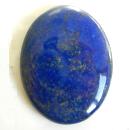|
Click on a letter above to view the list of gems. |
|
|
|
|
|
|
|
|
Lazurite
(Lapis
Lazuli) |
|
| Chemistry: Na6Ca2Al6Si6O24[(SO4),S,Cl,(OH)]2 | |
| Discovered
in 1890;
IMA
status: Valid (pre-IMA; Grandfathered). | ||
|
| ||
|
Classification |
|
|
| |
|
Silicates | |
|
|
8 : Silicates |
|
|
|
|
Crystal Data |
|
|
|
|
|
In dodecahedra, or more rarely cubes, up to 5 cm; granular, disseminated, or massive. |
|
|
None |
|
|
|
|
|
Physical Properties |
|
|
|
|
|
[110] Imperfect |
|
|
Irregular, Uneven |
|
|
Brittle |
|
|
5.5 |
|
|
2.38 - 2.42 (g/cm3) |
|
|
Fluorescent |
|
|
Not Radioactive |
|
|
|
|
|
Optical Properties |
|
|
|
|
|
Blue, Azure blue, Violet blue, Greenish blue |
|
|
Translucent, Opaque |
|
|
Vitreous to Dull |
|
|
1.50 - 1.522 Isotropic |
|
|
0.00 (Isotropic) |
|
|
0.014 (low) |
|
|
Distinct; purplish-red - orange-red |
|
|
Anomalous |
|
|
|
|
|
Occurances |
|
|
|
|
|
Geological Setting: |
A contact metamorphic mineral in limestones. |
|
Type Locality: |
Lapis-lazuli Mine, Sar-e-Sang, Badakhshan (Badakshan; Badahsan) Province, Afghanistan |
|
Year Discovered: |
1890 |
|
View mineral photos: | |
|
|
|
|
More Information |
|
|
|
|
|
| |
|
|
|
|
The name Lazurite is often confused with another blue mineral, the phosphate mineral Lazulite. Although the names are similar, their crystal habit is very different. Lazurite is very rarely found as distinct crystals and Luzulite has good crystal habit and vitreous luster. The carbonate mineral Azurite has a very similar color to Lazurite but is associated with the green carbonate mineral Malachite and reacts to acids. Lapis
Lazuli has been mined for centuries from a source still
in use today in the remote mountain valley of Kokcha,
Afghanistan. Although there are other sources of Lapis
worldwide, Afghanistan still produces the finest quality
material. |
|
|
We
have not photographed our Lapis Lazuli gems yet. Please
check back soon! |
